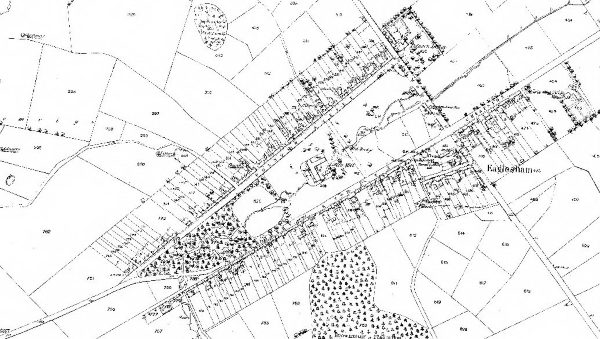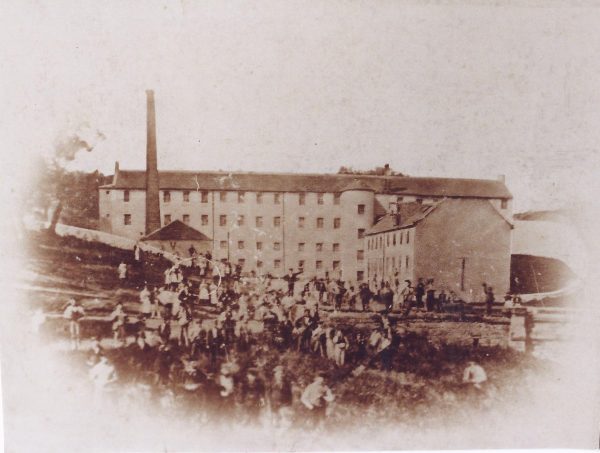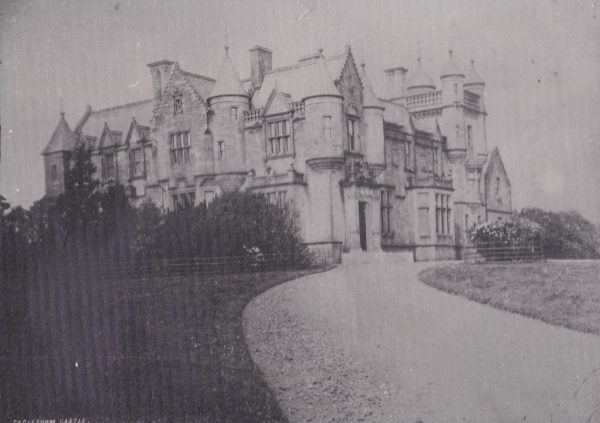

History of Eaglesham
Read on to discover the origins of Eaglesham
Eaglesham is bursting with history, with its most notable feature being an outstanding example of an 18th century planned village. However, there is much more to explore and this article gives an overview of the history of this remarkable place.
Early History
Eaglesham was part of land given to Walter, High Steward of Scotland, by King David I in the 12th century. He in turn granted it to Robert de Montgomery, grandson of the Earl of Shrewsbury, probably as part of a marriage dowry, when Robert married Walter’s daughter. It remained in the hands of the Montgomery family until 1844 when it was sold to the Gilmour Brothers.
In 1445 the owners were granted the title Lord Montgomery, and in 1506 Hugh Montgomery became the first Earl of Eaglesham, after supporting the future King James IV in the struggle against his father.
In 1615 it passed to a different branch of the family. The fifth Earl had left no heir and so it passed through his aunt, Countess of Winton, to her younger son Alexander Seton. Alexander was known as Greysteele. To show the change of line, the spelling was changed to Montgomerie.
Until the 18th century, there were few villages in Scotland. Patterns of rural settlement were loosely organised around fermtouns, each one consisting of a small cluster of tenants who worked the surrounding land together. Settlements which included a church were known as ‘kirktouns’ and those including mills ‘milltouns’. Before 1769, the parish of Eaglesham consisted of a kirktoun with about 25 houses and by the 1750s about 126 fermtouns.
The period of the mid 18th century to the early 19th century became known as the Age of Improvement. Many landowners, like Alexander 10th Earl of Eglinton, (pictured right), were keen to bring in new methods of farming and replace the old patterns of settlement with something much more organised and productive.
In rural areas, the old fermtouns were swept away and replaced by larger, enclosed single-tenanted farms. Landowners planned and built new villages which were much more regular in their layout. The new system of farming, combined with improvements in agricultural methods, resulted in a higher yield but also created a surplus of agricultural labour. A planned village could absorb both.

The Planned Village
Alexander decided to establish a planned village in Eaglesham. The old Kirkton which had grown around the church was replaced by the new layout which had two streets running on either side of a village green and which had road across the middle.

Land was sectioned off and let on 900 year leases. Tenants had a obligation to build a house within 5 years or lose their land. They were also obligated to clear the banks of the river. However, in return the Earl let them quarry stone and take sand from his estate for house building.
The common ground in between the new North and South Streets ( Polnoon and Montgomery Street) became known as ‘The Orry’. The tacksmen were allowed to use the burn running down its centre for washing and its green for bleaching, and it was intended as a place of beauty for the common good.
As a result of Alexander’s agricultural improvements, the number of farms in the area was reduced by half by 1789, and much of the surplus labour had moved to the village to provide other services, for example by 1791, there were silk weavers, joiners, smiths, shoemakers, bakers, tailors, coopers, horse-dealers and 8 pubs.
The tacksmen were very proud of the village. They called themselves Feuars and formed the Feuars’ Association. They inspected the village on horseback to ensure it was clean and tidy and engaged a piper to wake the village at 6.30am.
The 10th Earl died a violent death, aged only 46, before his planned village was completed. He was shot dead on his Ayrshire Estate, during a confrontation with excise officer Mungo Campbell, on October 19th 1796. However, his brother Archiebald, 11th Earl of Eglinton carried on his work by finishing the planned village and making new improvements of his own.
The Industrial Revolution
In addition to the age of agricultural improvement, the arrival of the industrial revolution in the second half of the 18th century heralded a great change in the life of people in the area.
Many people were drawn away from rural areas, attracted by the employment opportunities in the mills and factories springing up and to the towns which were growing around them. Probably to counteract this, the 11th Earl encouraged the building of two cotton mills in the village, and this, as well as hand weaving provided employment and encouraged the growth of Eaglesham during this period. The ‘Old’ Mill sat at the top of the village at Townhead while the newer mill was in the middle of the Orry.

To accommodate the increased population, more houses were built, bringing Montgomery Street (South Street) and Polnoon Street. (North Street) almost to a point. By 1845, the mill in the Orry employed 200 people, many of whom were children. While the mill was open Eaglesham became a busy village, but this was short lived as the textile industry was in steep decline everywhere by the end of the 19th century. In Eaglesham, the demise of the industry came early, in 1876, when the mill in the Orry was destroyed by fire and never rebuilt and the population began to decline.
Village Life
Due to the increase in the population Eaglesham developed facilities which allowed it to cater for the recreational, education and religious aspects of village life.
By the mid-19th century, Eaglesham had a small library, 3 schools plus the parish school, a friendly society, a post office and a farmer’s society – as well as 15 pubs! The Farmer’s society began to hold cattle shows every year, the first being in 1831. These carried on until the 1930s.
Eaglesham had long had a church, in fact the name Eaglesham is probably from the words ‘eglis’ church and ‘ham’ for hamlet. The Kirk in the village, which was originally octagonal in shape, was rebuilt in 1789/90 by the 11th Earl.
Because of the cotton mills a lot of people from Ireland came over to work and live in East Renfrewshire. This caused the Roman Catholic population to grow and in 1858, St. Bridget’s in Eaglesham was opened. St. Bridget’s had to serve a huge area including Newton Mearns, Clarkston, Giffnock, East Kilbride as well as Busby. In those days, people would walk the long distance there and back.
The Gilmours
After centuries of ownership, the Eglinton connection with Eaglesham was severed in 1844 when Archiebald, 13th Earl, sold it to The Gilmour brothers, Allan and James.
The 12th Earl, Hugh, had died leaving massive debts, largely due to over investing in a scheme to build a giant harbour at Ardrossan linked to Glasgow by canal. Eaglesham was first advertised for sale as early as 1835. Allan Gilmour was a founder and partner in the firm of Pollok & Gilmour (ship owners and timber importers) who had retired in 1839. The Gilmours moved into Polnoon Lodge which had originally been the hunting lodge used by the 9th Earl. However, in 1859-1860 the Gilmours built the very grand Eaglesham Mansion House.

Allan Gilmour (son of James), who inherited both his father and uncle’s shares of the estate refused to allow the railway to come to Eaglesham. In the short term, this prevented new industry from being established and also prevented its transformation to a residential suburb in the way of Busby and other areas in East Renfrewshire. However, in the long term, the lack of the railway helped preserve the character of the planned village.
Despite this, there was a slight rise in population in the first few decades of the 20th century. During this time, Eaglesham had gone back to being a quiet country village enticing people to buy holiday homes there. In fact many of the villagers supplemented their incomes by renting out parts of their homes in the summer.
Decline and rehabilitation of the village
By the 1930s, the Gilmours had sold Eaglesham and the village fell into a sharp decline. Many houses were empty and becoming derelict. Some inhabitants were not paying rent and were technically squatting. In the late 30s, there was proposal that the whole village should be bulldozed and replaced by a council house scheme.
The advent of World War II meant that thankfully, these plans had to be abandoned. However, the village continued to deteriorate. In 1953, the Stathaven Road council housing scheme was completed. People moved into the new houses leaving even more of the old village houses abandoned.
However, in 1956, the Preservation Society was formed by villagers. They wrote to the secretary of State for Scotland and to the National Trust for Scotland and interest in their cause began to spread.
In 1960, the buildings in the village were listed as a group – the first time this had ever happened and in 1967, Eaglesham was made a conservation area and collectively designated as Category A.
Since then many cottages and houses have been restored and gap sites filled in. Polnoon Lodge was restored and a tenement block (Coronation Buildings) was demolished as it was not in keeping with the village.
Today Eaglesham is a thriving community and is an outstanding and well preserved example of an 18th century planned village.
Further Reading
A Planned Village: A History of Eaglesham, Eastwood District Libraries, 1988
Brown, Christina Robertson, Rural Eaglesham, William Maclellan, 1966
Deighton, Jane Scott, Eaglesham: An Earl’s Creation, Johnson, 1974
Welsh, Thomas C., Eastwood District History and Heritage, Eastwood District Libraries 1989
Wilson, Rhona, Old Eaglesham, Stenlake Publishing, 1997
